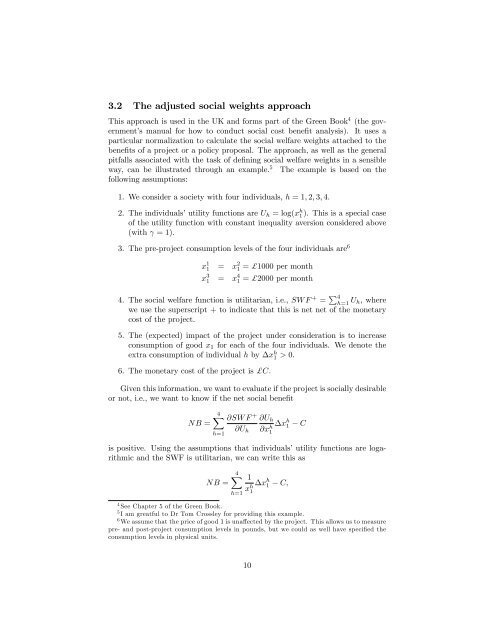Lecture Note 15: Social Cost Benefit Analysis - University of ...
Lecture Note 15: Social Cost Benefit Analysis - University of ...
Lecture Note 15: Social Cost Benefit Analysis - University of ...
You also want an ePaper? Increase the reach of your titles
YUMPU automatically turns print PDFs into web optimized ePapers that Google loves.
3.2 The adjusted social weights approach<br />
This approach is used in the UK and forms part <strong>of</strong> the Green Book 4 (the government’s<br />
manual for how to conduct social cost bene…t analysis). It uses a<br />
particular normalization to calculate the social welfare weights attached to the<br />
bene…ts <strong>of</strong> a project or a policy proposal. The approach, as well as the general<br />
pitfalls associated with the task <strong>of</strong> de…ning social welfare weights in a sensible<br />
way, can be illustrated through an example. 5 The example is based on the<br />
following assumptions:<br />
1. We consider a society with four individuals, h = 1; 2; 3; 4.<br />
2. The individuals’utility functions are Uh = log(x h 1). This is a special case<br />
<strong>of</strong> the utility function with constant inequality aversion considered above<br />
(with = 1).<br />
3. The pre-project consumption levels <strong>of</strong> the four individuals are 6<br />
x 1 1 = x 2 1 = $1000 per month<br />
x 3 1 = x 4 1 = $2000 per month<br />
4. The social welfare function is utilitarian, i.e., SW F + = P 4<br />
h=1 Uh, where<br />
we use the superscript + to indicate that this is net net <strong>of</strong> the monetary<br />
cost <strong>of</strong> the project.<br />
5. The (expected) impact <strong>of</strong> the project under consideration is to increase<br />
consumption <strong>of</strong> good x1 for each <strong>of</strong> the four individuals. We denote the<br />
extra consumption <strong>of</strong> individual h by x h 1 > 0.<br />
6. The monetary cost <strong>of</strong> the project is $C.<br />
Given this information, we want to evaluate if the project is socially desirable<br />
or not, i.e., we want to know if the net social bene…t<br />
NB =<br />
4X @SW F +<br />
h=1<br />
@Uh<br />
@Uh<br />
@x h 1<br />
is positive. Using the assumptions that individuals’utility functions are logarithmic<br />
and the SWF is utilitarian, we can write this as<br />
NB =<br />
4X<br />
x<br />
h=1<br />
h 1<br />
4 See Chapter 5 <strong>of</strong> the Green Book.<br />
5 I am greatful to Dr Tom Crossley for providing this example.<br />
6 We assume that the price <strong>of</strong> good 1 is una¤ected by the project. This allows us to measure<br />
pre- and post-project consumption levels in pounds, but we could as well have speci…ed the<br />
consumption levels in physical units.<br />
1<br />
10<br />
x h 1<br />
x h 1<br />
C;<br />
C


